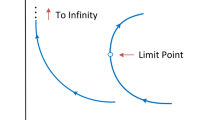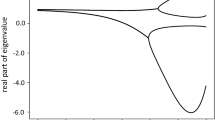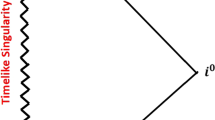Abstract
The Hamiltonian structure for a fundamental model of a tethered satellite system is constructed. The model is composed of two point masses connected by a string with no restrictions on the motions of the two masses. A certain symmetry with respect to the special orthogonal group SO(3) for such a system is observed. The classical station-keeping mode for the tethered system is found to be nothing more than the relative equilibrium corresponding to the reduction of the system by the symmetry. The microgravity forces on the two point masses are responsible for the possible configurations of the string at the so-called radial relative equilibrium. A stability analysis is performed on the basis of the reduced energy-momentum method. Criteria for stability are derived, which could find potential applications in space technology.
Similar content being viewed by others
References
R. Abraham & J. E. Marsden. Foundations of Mechanics. Benjamin/Cummings, Reading, 2nd edition, 1978.
S. S. Antman. The equations for large vibration of strings. Amer. Math. Monthly, 87, 159–170 (1980).
S. S. Antman & P. Wolfe. Multiple equilibria of elastic strings under central forces. J. Differential Equations, 47, 180–213 (1983).
V. V. Beletsky & E. M. Levin. Dynamics of space systems including elastic tethers. In N. V. Bamchuk, D. M. Klimov & W. Schiehlen, editors, Dynamical Problems of Rigid-Elastic Systems And Structures, 17–26. Springer-Verlag, 1990.
R. V. Churchill. Expansions in series of nonorthogonal functions. Bull. Amer. Math. Soc., 48, 143–149 (1942).
G. Colombo, E. Gaposchikin, M. Grossi & G. Weiffenbach. Shuttle-borne skyhook: A new tool for low-orbital-attitude research. Technical report, SAO Report, September 1974.
E. J. Fleurisson & A. H. von Flotow. Trajectory design, feedforward, and feedback stabilization of tethered spacecraft retrieval. J. Guidance, Control, and Dynamics, 16, 160–167 (1993).
M. D. Grossi. A ULF dipole antenna on a spaceborne platform of the PPEPL class. Technical report for NASA Contract NAS8-28203, May 1973.
R. J. Kline-Schoder & J. D. Powell. Precision attitude control for tethered satellites. J. Guidance, Control, and Dynamics, 16, 168–174 (1993).
E. M. Levin. Stability of the stationary motions of an electromagnetic tether system in orbit. Cosmic Research, 25, 368–376 (1987).
D. C. Liaw & E. H. Abed. Stabilization of tethered satellites during station keeping. IEEE Trans, on Automatic Control, 35, 1186–1196 (1990).
L. D. Liu & P. M. Bainum. Effect of tether flexibility on the tethered shuttle subsatellite stability and control. J. Guidance, 12, 886–873 (1988).
J. E. Marsden. Lectures on Geometric-Methods in Mathematical Physics. SIAM, Philadelphia, PA, 1981.
R. S. Palais. The principle of symmetric criticality. Comm. in Math. Physics, 69, 19–30 (1979).
M. Pasca, M. Pignataro & A. Luongo. Three-dimensional vibrations of tethered satellite system. J. Guidance, 14, 312–320 (1991).
A. Pazy. Semigroups of Linear Operators and Applications to Partial Differential Equations, Springer-Verlag, 1983.
P. A. Penzo & P. W. Ammann, editors. Tethers in Space Handbook. NASA, 1989.
M. Shearer. Elementary wave solutions of the equations describing the motion of an elastic string. SIAM J. Math. Anal., 16, 447–459 (1985).
M. Shearer. The Riemann problem for the planar motion of an elastic string. J. Differential Equations. 61, 149–163 (1986).
J. C. Simo, T. Posbergh & J. E. Marsden. Stability of coupled rigid body and geometrically exact rods: Block diagonalization and the energy momentum method. Phys. Reports, 193, 279–360 (1990).
J. C. Simo, D. Lewis & J. E. Marsden. Stability of relative equilibria, part I: The reduced energy-momentum method. Arch. Rational Mech. Anal., 115, 15–59 (1991).
S. R. Vadali & E. S. Kim. Feedback control of tethered satellite using Lyapunov stability theory. J. Guidance, 14, 729–735 (1991).
L. S. Wang & P. S. Krishnaprasad. Gyroscopic control and stabilization. J. Nonlinear Sci., 2, 367–415 (1992).
Author information
Authors and Affiliations
Additional information
Communicated by P. Holmes
Rights and permissions
About this article
Cite this article
Wang, L.S., Chern, S.J. & Shih, C.W. On the dynamics of a tethered satellite system. Arch. Rational. Mech. Anal. 127, 297–318 (1994). https://doi.org/10.1007/BF00375018
Accepted:
Issue Date:
DOI: https://doi.org/10.1007/BF00375018




